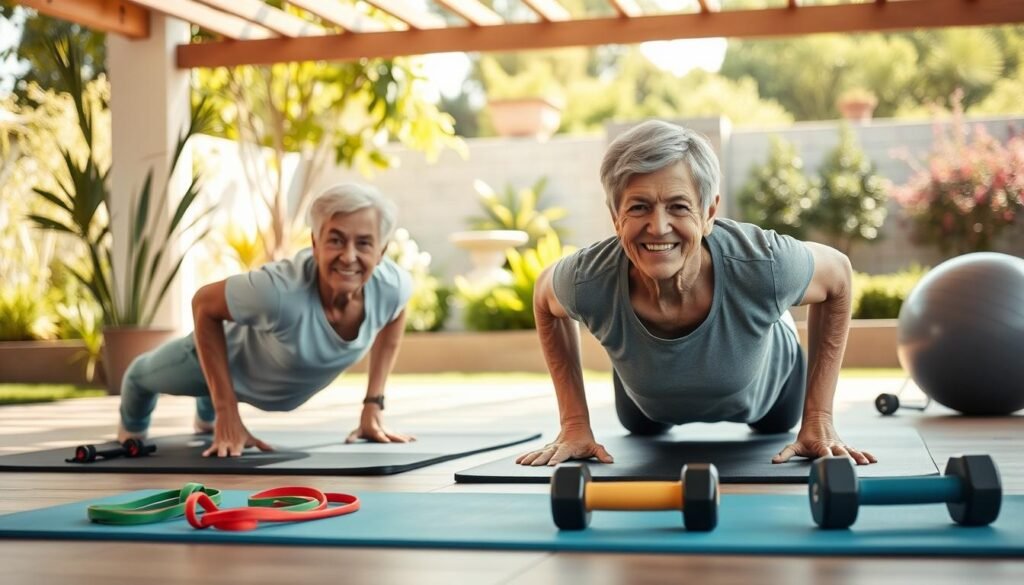Exercise is key for seniors, but sadly, one in four adults don’t get enough. Rebound pushups are a safe way to strengthen and move without hurting your joints. They’re made for seniors, blending pushups with the soft bounce of a mini-trampoline.
This exercise is great because it’s easy on your knees and hips. It lets you work out your upper body even if you have mobility issues.
Getting fit as a senior doesn’t have to be scary. Rebound pushups work your core, boost your heart health, and help you balance. They’re also easy on your body.
For instance, a 135-lb person can burn 95 calories in just 15 minutes. Plus, they can lower your stroke risk by 27% and help fight osteoporosis. This condition affects 10 million Americans. Rebound pushups are perfect for anyone, whether you’re just starting out or want to stay active.
Key Takeaways
- Rebound pushups reduce joint stress while building upper-body strength.
- They improve balance, lowering fall risk for seniors.
- Short sessions (15 minutes) burn calories and support weight management.
- Enhances bone density to combat osteoporosis and improve overall health.
- Perfect for all fitness levels with adjustable intensity and safety accessories.
What Are Rebound Pushups For Seniors?
Rebound pushups are a special kind of pushup for seniors. They help build strength without putting too much pressure on joints. These rebound exerciser methods use a bouncy motion to work muscles in a new way. Let’s explore how they work and why they’re good for your fitness.
The Mechanics Behind Rebound Exercises
Rebound pushups are different from regular pushups. They use momentum instead of slow, steady force. By bouncing up after lowering your body, you work more stabilizer muscles. This makes them easier on your wrists and shoulders, perfect for those with joint issues.
The trick is to move smoothly, like “push, pause, push.” This rhythm helps you do each rep better.
How Rebound Pushups Differ From Traditional Pushups
Traditional pushups keep your arms and core tight the whole time. Rebound pushups, on the other hand, add a bounce at the bottom. This makes them a low-impact exercise that’s easier on your joints but still works your muscles hard.
Why Seniors Should Consider This Exercise
Studies highlight three key benefits of rebound pushups:
- They build upper-body strength without heavy weights
- They improve balance by training reactive coordination
- They’re adaptable to any fitness level
Coach Glassman mentioned in 2003 that even modified versions can boost functional strength. Research also shows seniors can see up to a 20% improvement in stability. This is crucial for preventing falls.
Want to give them a try? Start slow and focus on your form. Your body will get stronger and more mobile.
The Benefits of Rebound Pushups for Older Adults

Rebound pushups are more than just a workout—they’re a path to better senior health and wellness. They gently work your muscles and joints, fitting your needs perfectly. Let’s explore how they help:
Imagine carrying groceries or climbing stairs without effort. Rebound pushups make your upper body stronger, making everyday tasks easier. They also help your joints, like shoulders and elbows, feel better and move more freely. NASA found that rebounding can even build muscle and bone, helping fight osteoporosis.
Here’s what science says matters most for older adults:
| Benefit | Data-Driven Impact |
|---|---|
| Balance improvement | Enhances proprioception, cutting fall risks by improving coordination. |
| Cardiovascular health | Burns 95 calories in 15 minutes and strengthens heart muscles. |
| Immune support | Boosts lymph flow up to 30x faster, aiding toxin removal and immunity. |
| Weight management | Helps shed 1 lb/week by burning calories and reducing appetite. |
They’re low-impact, which means less stress on your joints while still building bone strength. Better circulation brings oxygen to your muscles, giving you more energy. Even short workouts (5-10 minutes) can boost your metabolism and endurance. For senior workouts, rebound pushups are a safe, effective way to stay active and reduce chronic pain like back discomfort.
Don’t let past fitness struggles stop you. Whether you’re new to exercise or looking for gentle movements, these exercises fit your pace. Every rep brings you closer to stronger muscles, better balance, and the confidence to enjoy life fully.
Getting Started With Rebound Exercise Equipment
Starting with senior rebounding
Pick Your Rebound Surface
There are many choices, like mini trampolines or soft mats. Look for stable, non-slip surfaces to avoid falls. For example, chair yoga programs use similar surfaces.
Lightweight foam pads are great for beginners. Adjustable rebounders help you grow stronger.
Safety First: Accessories to Keep Nearby
- Anti-slip mats or yoga towels
- Supportive grips for hands and feet
- Portable balance bars or walls for stability
Wear breathable clothes and moisture-wicking socks for comfort.
Design Your Safe Space
Clear a 3×3 foot area of clutter. Good lighting is key to seeing around you. Have a chair nearby for balance checks.
Start with 10–15 minute sessions, 3 times a week. Begin with 5 jumps or bounces and increase as you get more comfortable.
Even small steps, like setting up senior exercise equipment at home, can help prevent falls. Always put safety first and adjust your gear to fit your space and needs.
Proper Form and Technique for Rebound Pushup For Seniors

Learning the right form is key to safely building strength with rebound pushups. Place your hands shoulder-width apart, with fingers pointing forward. Keep your body straight, from head to heels, like a plank.
Lower yourself slowly, keeping your body aligned as you move towards the floor.
Step-by-Step Guide to Perfect Form
- Align hands directly under shoulders, palms flat, fingers spread.
- Inhale as you lower with controlled speed, aiming for 2 seconds down.
- Pause briefly at the bottom, ensuring chest nearly touches the mat without collapsing hips.
- Exhale forcefully as you push back up, taking 2 seconds to reach full arm extension.
Common Mistakes to Avoid
- Sagging hips: Letting your lower back dip creates strain.
- Elbows flaring outward strains shoulders—keep them at 45° from the body.
- Rushing the motion reduces midline stability benefits. Stick to the 2/2 second tempo.
Breathing Techniques During Execution
Match your breathing with the movement: exhale sharply when pushing up, inhale slowly when lowering. For beginners, focus on smooth breathing to help engage your core. Proper form helps prevent falls and strengthens your legs and core.
For more on low-impact exercises, check out this link.
Modifications and Variations for Different Ability Levels

Seniors can make rebound pushups fit their fitness goals with pushup variations for seniors. Start with low-impact exercises like wall pushups. Here, you lean against a sturdy surface instead of the floor. This makes it easier while still building strength.
Elevating your hands on a bench or chair also helps reduce the workout’s intensity. This makes it easier for you.
- Beginner Options: Use a stability ball or foam roller under your chest to support upper-body movements.
- Intermediate Adjustments: Try knee-supported pushups or slow-motion repetitions to focus on form.
- Advanced Challenges: Add a medicine ball under your chest for instability training or incorporate explosive movements.
Marc, a senior fitness specialist, suggests starting with the Easy Sway exercise. This involves two bounces per foot to improve balance. Next, try the Narrow basic bounce with arm movements for better coordination.
To boost your heart rate, increase the number of bounces while keeping control. Always put safety first—don’t push too hard and check with a doctor before starting.
These low-impact exercise changes make workouts safe yet effective. Mix in exercises like Modified Knee Ups (4 repetitions per leg) with rest periods. Remember, being consistent is more important than how hard you work. Adjust as needed to stay comfortable and meet your goals.
Incorporating Rebound Pushups Into Your Weekly Senior Workout Routine
Starting with rebound pushups in your senior workout routines means being consistent. Start with a beginner’s plan: do 3×8 reps on Monday, Wednesday, and Friday. Use a rack for support. On Tuesdays and Thursdays, do slow eccentrics (10-second lowering phase) to build strength. Saturdays are for bottom-position pushups.
This plan balances how hard you work out and how much rest you get. It helps avoid getting too tired.
One in three adults aged 65 and older will fall this year, according to the CDC.
As you get better, slowly increase the number of reps. Aim to do 15 reps per set in 8 weeks. Also, do slow-motion pushups (5-10 reps, 5-second tempo) to improve your form.
For a full senior fitness program, add:
- Walking heel-to-toe for balance
- March in place while holding onto a chair
- 10-15 minutes of chair-based squats
Studies show that focusing on strength can cut falls by 31% (University of Sydney, 2023). Mix rebound pushups with flexibility exercises like shoulder rotations (5-10 each side) and seated forward bends. The U.S. Department of Health suggests doing balance exercises three times a week. This is easy with this plan.
Looking for motivation? Rebounding workouts on mini-trampolines are fun and good for your heart. Keep track of your progress each week. Celebrate small victories like adding one more rep or holding a plank 5 seconds longer.
Safety Considerations and When to Avoid Rebound Exercises
Choosing the right exercises is key for senior health and wellness. Before starting senior rebounding, talk to a doctor if you have arthritis, osteoporosis, or heart problems. In 2018, over 300,000 trampoline injuries were reported in the U.S., with 110,000 needing emergency care. It’s important to focus on safety to enjoy rebounding without getting hurt.
“Balance exercises are critical for seniors to prevent falls and maintain mobility.” – U.S. Department of Health and Human Services
- Contraindications: Don’t rebound if you have acute joint inflammation, recent surgeries, or uncontrolled heart conditions.
- Warning signs: Stop if you feel sharp pain, dizziness, or shortness of breath.
- Equipment quality matters: Pick sturdy models like ACON rebounders, with 10-year warranties and UV-resistant frames.
Start with short sessions (3–5 minutes) and slowly increase the time. Always warm up with light cardio and stretches. Use handlebars for stability, especially if you’re new to senior rebounding. Pair exercises with strength training like the Densercise™ Epidensity program for balanced bone health. Focus on form over intensity to avoid overexertion.
Rebounding is low-impact, making it great for many seniors. But safety is the top priority. Listen to your body and adjust routines as needed. With the right precautions, rebounding is a safe way to improve heart health, lymph flow, and balance—all important for senior health and wellness.
Conclusion: Embracing Rebound Pushups for Lifelong Strength and Mobility
Rebound pushups are a gentle way to build strength and keep joints healthy. They can be done on a stability ball or a padded mat, which are key senior exercise equipment. These exercises help you stay active and independent.
They also improve flexibility, making everyday tasks like reaching shelves or bending over easier. This is especially true as you get older.
Start slow with a few modified pushups each day. Adding them to your routine can make a big difference. Mix them with other senior workouts like seated stretches or balance drills for a balanced fitness plan.
Always focus on proper form, not how fast you do it. Use cushions or grip pads if you need to.
Don’t let fear stop you. Start with the knee-supported version and slowly add more reps. Every pushup you do helps improve your posture, strengthens your muscles, and boosts your confidence.
Your health journey is unique, so celebrate every small victory. Investing in your health today means enjoying life more tomorrow. Take the first step and see how rebound pushups can change your active lifestyle.
FAQ
What are rebound pushups specifically designed for seniors?
Rebound pushups are a new exercise for seniors. They use a rebounder to make pushups easier on the joints. This helps build upper body strength and keeps joints safe.
How do rebound pushups help seniors improve their strength?
Rebound pushups use a rebounder to work muscles gently. This way, seniors can strengthen their upper body without too much strain. It’s great for everyday activities and helps keep them independent.
Can I do rebound pushups even if I’ve never exercised before?
Yes, you can! Rebound pushups can be adjusted to fit your fitness level. Start with easier versions and get stronger and more confident over time. It’s a safe way to start exercising.
What safety equipment do I need for rebound pushups?
You’ll need a stable rebound surface and mats for comfort. Also, non-slip gloves and support bars are helpful. These items make sure you’re safe and can exercise well.
What should I consider when setting up my workout space for rebound pushups?
Your space should be well-lit and clutter-free. Make sure it’s big enough to move around. Have a good rebound surface and safety gear nearby. Having someone to help is also a good idea.
How can I modify rebound pushups to suit my ability level?
You can start with wall-based pushups or use elevated surfaces for a challenge. As you get stronger, try harder versions. Always choose what feels right for you.
What should I do if I experience pain while doing rebound pushups?
If you feel pain, stop and check your form or level. Always talk to a doctor if you have concerns, especially about injuries or health conditions. Listen to your body to stay safe.
How can I incorporate rebound pushups into my overall fitness routine?
Mix rebound pushups with other exercises for a balanced routine. Include cardio, flexibility, and lower body workouts. Use sample plans to help you fit rebounding into your schedule.
Are there any health conditions that would prevent me from doing rebound pushups?
Yes, some conditions like joint inflammation or heart issues might not be good for rebound pushups. Always check with your doctor before starting any new exercise, especially if you have health concerns.
Source Links
- https://leapsandrebounds.com/blogs/news/what-are-the-best-mini-trampoline-and-rebounder-workouts-for-beginners?srsltid=AfmBOoqBsKzAWdWixyVPmS56H6QIdUUj8YsTrH7RYbn8G_JfJkF2lnfK – What are the Best Mini-Trampoline and Rebounder Workouts for Beginners?
- https://cellercise.com/pages/health-benefits-list-home-gym-rebounder?srsltid=AfmBOoqQoER9tU5CQCR3r7kr7XiV3CoFqicjCmT-LwEkxfQV5VxKRXYx – Home Gym Rebounder – Health Benefits List
- https://leapsandrebounds.com/blogs/mini-trampoline-workouts/rebounding-for-seniors?srsltid=AfmBOooXqhz728DuuznXd4lv9cd0_MqvYb46rF4mIOhtIO40fWvMYUHl – Rebounding for Seniors
- https://us.humankinetics.com/blogs/excerpt/strength-and-power-exercises-for-older-adults?srsltid=AfmBOoqjnkM2BvWFI3yG0xRutGsJKwIJBD0T05-lLGZ7t8roYE7JXzXn – Strength and power exercises for older adults
- https://cellercise.com/pages/health-benefits-list-home-gym-rebounder?srsltid=AfmBOoqDVbubh71AX_6S2-4ss1oJGxMyguVEF9m3iHREpgfudLv_iiku – Home Gym Rebounder – Health Benefits List
- https://www.needak.co.uk/rebounder-health-benefits – Needak UK – The Health Benefits of Rebounding
- https://us.humankinetics.com/blogs/excerpt/strength-and-power-exercises-for-older-adults?srsltid=AfmBOopuXiHVgCLv8N_9NHZ4i0IE5FPFFfFNGPxLU5rXARqL_0jBe8VR – Strength and power exercises for older adults
- https://seasonsretirement.com/5-simple-and-safe-exercises-for-older-adults/ – 5 simple and safe exercises for older adults | Seasons Retirement Communities
- https://universityhealthnews.com/free-reports-online/easy-exercises-stretches-seniors-can-improve-stability-core-strength-prevent-falls/ – Easy Exercises and Stretches: How seniors can improve stability and core strength and prevent falls
- https://www.crossfit.com/pro-coach/the-lowly-push-up-revisited – The Lowly Push-Up Revisited
- https://leapsandrebounds.com/blogs/mini-trampoline-workouts/rebounding-for-seniors?srsltid=AfmBOoqYyU3ygmtYTLI4Fe2DJ7QA5djMv8Lw_8Gh_AFSxd_Tg8yh0qYt – Rebounding for Seniors
- https://us.humankinetics.com/blogs/excerpt/strength-and-power-exercises-for-older-adults?srsltid=AfmBOoq2eGFfoKithW39zfdbjy-49MtaWCfizJB3RmAu4TH7gti_GL6v – Strength and power exercises for older adults
- https://saveourbones.com/rebounding-good-or-bad-for-your-bones/ – Rebounding: Good Or Bad For Your Bones?
- https://www.webmd.com/fitness-exercise/what-to-know-about-trampoline-workouts – What to Know About Trampoline Workouts
- https://ca.acon24.com/blogs/the-launch-pad/what-is-rebounding-simple-guide-to-trampoline-exercise?srsltid=AfmBOooWYIXNXjQ0TPWIisZ_vrW1RfL1_mmZkLdawG9Idr7Z6AbJXxSG – What is Rebounding? Simple Guide to Trampoline Exercise

